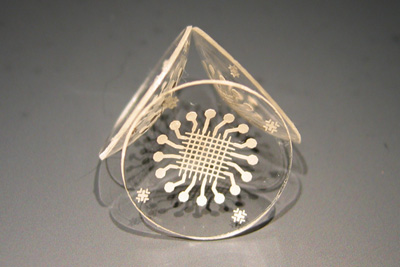
There may be something stealing your vision. But no matter how hard you look, you won’t be able to find the culprit. These vision thieves take your sight without any signs that are visible to the naked eye.
With the new “smart” contact lens you may be able to detect signs of glaucoma, a disease that causes blindness, in the comfort of your very own home. Traditionally, glaucoma has only been detectable by eye doctors.
UC Davis biomechanical engineers have developed a new device called the “smart” contact lens to measure pressure within the eye. High eye pressure can be a sign of glaucoma.
According the World Health Organization, glaucoma is the second-leading cause of blindness in the world.
Everyone is at risk for glaucoma, from babies to senior citizens, said Hailin Cong, researcher and post-doctoral scholar of the biomechanical engineering department.
“Estimates put the total number of suspected cases of glaucoma at around 65 million worldwide and more than 10 percent of them are bilaterally blind,” Cong said in an e-mail interview. Bilateral blindness means loss of vision in both eyes.
In the United States alone, over 3 million people have glaucoma and this number is expected to increase by 50 percent by 2020, due to the aging population, he said.
The way the “smart” contact lens works is by measuring stress on the corneal surface and the fluid pressure within the eye, Cong said.
“The eye always has a certain pressure, which is why the eyeball is a sphere,” he said. “In glaucoma patients, that pressure rises and changes the shape of the eye, which would deform the contact lens sensor.”
The sensors in the “smart” contact lens work similarly to those in an iPhone that detect any pressure exerted against them, said Tingrui Pan, principle investigator of the research project.
“When you press the iPhone display, it senses your fingers,” Pan said. “The sensors in the ‘smart’ contact lens are extremely sensitive and can read any mechanical force on it electronically.”
These lenses will be the next generation of glaucoma diagnostic system, Cong said.
“It not only can be used in hospitals to diagnose and check glaucoma through the much more expensive professional physician interface,” he said, “but also can be used at home to monitor glaucoma and ocular hypertension through a wireless personal computer interface.”
The measurement usually takes 10 to 15 minutes.
The lens has already been tested in a human eye for 20 minutes without noticeable irritation, Cong said.
The type of silicone used in commercial contact lenses, polydimethylsiloxane (PDMS), is exactly the same as that used for the “smart” contact lens, he said.
The silver particles placed on the contact lens work as conductive wires and doubles as antimicrobial agents.
“The silver particles in PDMS matrix greatly decrease the amount of bacteria adhered to the surface and thus improve the antibacterial property of the contact lens,” Cong said.
The “smart” contact lens is an advancement compared to current methods in that it is non-invasive and the measured pressure signal is also real-time with less errors and limitations, he said.
But while it is able to detect signs of glaucoma, it cannot simultaneously provide treatment.
In the future, the researchers’ goal is to integrate the contact lens with the glaucoma diagnostic sensor and treatment device together, Cong said. They also hope to use nanotechnology to make transparent conductive circuits so that the contact lens will have transparent sensors on it.
This advanced type of lens will look like a common contact lens, but will integrate even more functionality for monitoring and treatment of different eye diseases, he said.
“Using the biomechanical analysis based on real-time non-invasive imaging techniques,” Cong said, “glaucoma pathology can be understood better.”
While measuring eye pressure is important, the precise relationship between eye pressure and glaucoma is not known, said Annie Baik, clinical glaucoma fellow at Department of Ophthalmology at the UC Davis Medical Center.
There are people with high eye pressure who don’t have glaucoma, Baik said.
“And there are some people who have glaucoma and may have what is considered normal or low eye pressure,” she said.
To test for other signs of glaucoma, people can visit their optometrists or ophthalmologists for a clinical examination.
“In the office, we’re looking at the eye itself and looking at the optic nerve for characteristic changes that are consistent with glaucoma,” Baik said.
The “smart” contact lens is no substitute for corrective lenses however.
“The “smart” contact lens is not going to correct your vision,” Pan said.
There is usually no pain associated with glaucoma and significant vision may be lost by the time anything is noticed, Cong said. Experts estimate that half of the people affected by glaucoma may not know they have it.
“So the best way to protect our sight from glaucoma is to get tested frequently,” he said. “The earlier we detect it and treat it, the less chance it will cause blindness.”
THUY TRAN can be reached at features@californiaaggie.com.




